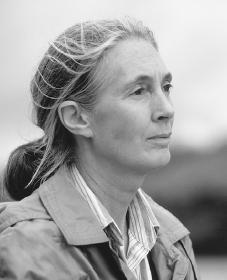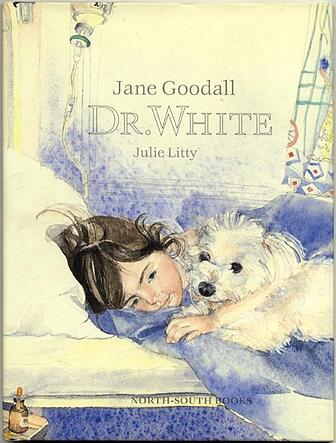Jane Goodall is the world’s foremost expert in chimpanzees. Born on April 3, 1934, she spent 45 years studying wild chimpanzees in Gombe Stream National Park, Tanzania. In addition to being honored as Dame Commander of the Order of the British Empire, she was named a United Nations Messenger of Peace in 2002. She has received many awards, including the French Legion of Honor, the Medal of Tanzania, the Kyoto Prize, and the Tyler Prize for Environmental Achievement. Yet, not only did Goodall make lasting contributions to science and environmentalism, she led a fascinating life. Learn twenty interesting facts about Jane Goodall below:
 1. Jane Goodall was first introduced to chimpanzees when she was a baby.
1. Jane Goodall was first introduced to chimpanzees when she was a baby.
Her father presented her with a toy chimpanzee when she was one year old. Goodall named it Jubilee, and the toy remained by her side for years. Even now, Goodall keeps Jubilee on her dresser.
2. As a child, Goodall loved books about animals and Africa.
She especially loved The Story of Dr. Dolittle and Edgar Rice Burrough’s Tarzan series. However, Goodall was disdainful of Tarzan's romantic interest, Jane Porter, and thought she would be a better romantic match for the tree-swinging hero.

3. Goodall observed animals from a young age.
Once, she sat for five hours in her family’s chicken coop to watch a hen lay an egg. When she finally came out, Goodall discovered that her family was frantic and had called the police to report her missing.
4. When Goodall graduated from high school, she couldn’t afford college tuition.
Instead, she worked for years as a secretary, a waitress, and a filmmaker’s assistant.
5. Goodall first traveled to Africa when she was 23 years old
Going to visit a friend in Kenya, she met famous anthropologist Dr. Louis S. B. Leakey, who hired Goodall as his assistant. He later sent her to Tanzania to observe chimpanzees.
 6. The British government mandated that she have a travel partner
6. The British government mandated that she have a travel partner
When Goodall first traveled to Tanzania in 1960, the British government mandated that she have a travel partner—it was deemed inappropriate for her to travel alone. So her mother joined her on the journey.
7. Chimpanzees use tools and are not vegetarian
Shortly after working in Tanzania, Goodall made two revolutionary observations about chimpanzees: 1) that they used tools, a behavior previously attributed only to humans; 2) chimpanzees were not vegetarian. Following these discoveries, National Geographic sponsored Goodall’s work, sending photographer Hugo van Lawick to document Goodall and the chimpanzees. Van Lawick and Goodall married in 1964.
8. She was a PhD candidate without a college degree
Goodall entered Cambridge University as a Ph.D. candidate in 1962—one of the first Ph.D. students accepted by the university without a college degree. She graduated in 1966 with a Ph.D. in Ethology. Her thesis was titled, "Behaviour of the Free-Ranging Chimpanzee."
9. Scientists disapproved naming chimpanzees rather than numbering them
Despite being recognized as the world’s foremost expert in chimpanzees, Goodall’s work has not escaped controversy. Some scientists disapproved that Goodall named chimpanzees rather than assigning them numbers. Others criticized her for using feeding stations to attract chimpanzees, arguing that she disrupted natural feeding patterns and encouraged aggression in the animals.
10. The London Times printed an obituary for a chimpanzee
Goodall’s books—especially Through a Window and In the Shadow of Man—became so popular that the chimpanzees she worked with became internationally and individually, known. When one of the chimpanzees died—old Flo—the London Times printed an obituary.
 |
The Chimpanzee; The Living Link between 'Man' and 'Beast' In this remarkable illustrated lecture, Jane Goodall describes her work in the Gombe Stream Game Reserve. Her efforts revealed how chimpanzees have unique personalities and develop complex psychological, social and political relationships with one another. |
 |
Hope for Animals and Their World From Jane Goodall's Introduction: "This book has taken me on a fantastic journey of exploration: I have learned ever more about animal and planet species brought to the brink of extinction by human activities and then, sometimes at the very last minute and against all odds, been given a reprieve." |
 |
The second volume and continuation of her 2000 autobiography in letters, Africa in my Blood. According to Goodall, this book includes the years of her greatest triumphs, her deepest tragedies, as well as her most important observations about chimpanzee behavior, including the dark discovery that chimpanzees wage war and commit murder just as humans do. |
 |
Who can fly the highest? "I can", claims the lark, the dove, the vulture, and—of course—the mighty eagle. To settle the dispute, the birds hold a contest to see who can soar to the greatest height. In The Eagle & The Wren, Jane Goodall retells a beloved fable from her own childhood, a story of teamwork and togetherness, and shares insights from her own life. |
 |
Jane Goodall tells the story of Dr. White who worked his magic on critically ill children. But his treatment methods, while often successful, were most unusual, and one day he was banned from the hospital. Everyone missed him, and his patients suffered in his absence. It took an unexpected tragedy and a miraculous cure to restore Dr. White to the patients he loved. |
11. She discovered a lot more than just tool use
 Though the fact that chimps used tools required humans to redefine their idea of what separates us from the animals, it wasn’t the only similarity that Goodall discovered between the two species. Like us, chimps also go through adolescence, show affection with hugs and kisses, practice politics, and wage war on ostensible enemies.
Though the fact that chimps used tools required humans to redefine their idea of what separates us from the animals, it wasn’t the only similarity that Goodall discovered between the two species. Like us, chimps also go through adolescence, show affection with hugs and kisses, practice politics, and wage war on ostensible enemies.
12. Her first trip to Africa got off to an…awkward start
Jane famously moved to Kenya as a young woman, where she met noted researcher Louis Leakey, who would ultimately send her to Gombe to study chimps. Before that happened, however, Leakey, despite being married with children, professed his love to the budding scientist. His profession was met with a curt refusal, but their friendship (seemingly) didn’t suffer.
13. She was briefly a baroness
Though Goodall was (probably fortuitously) not interested in the married Leakey, she would go on to marry her photographer, Hugo van Lawick. Or rather, Baron Hugo van Lawick. As a result, for the brief duration of their marriage, Goodall was an honest-to-goodness Baroness.
14. She (and her mother, and their cook) spent time in a prison camp
Jane famously had to be accompanied on her expedition by her mother because the local powers didn’t believe it was safe for a young woman to be out in the woods by herself. As it turns out, there were some very real safety concerns afoot—specifically, the civil war that had just broken out in the Belgian Congo. As a result of the conflict, it was determined that the safest place for Jane and her two-person entourage was a prison camp near Gombe, where they stayed until they were given the all-clear to head into the forest.
15. She was apparently a Lord of the Rings (1954) fan
Once Jane’s research got underway in earnest, it was not without its fair share of controversy. Most notably, many of Jane’s peers objected to her naming her subjects instead of numbering them. We at the Books Tell You Why blog have a general rule or staying out of scientific disputes, but on this score we have to express our appreciation for the fact that Goodall named one of her subjects Frodo, suggesting that she had at least read (and probably enjoyed!) J.R.R Tolkien’s classic fantasy epic.
16. Her methods were partially inspired by her childhood dog

Not only did other scientists criticize Goodall for naming her subjects, they were generally against what they perceived as a tendency to anthropomorphize the primates she was studying. Jane defended herself against her critics, saying, "You cannot share your life with a dog, as I had done in Bournemouth, or a cat, and not know perfectly well that animals have personalities and minds and feelings. You know it and I think every single one of those scientists knew it too but because they couldn't prove it, they wouldn't talk about it. But I did talk about it. In a way, my dog Rusty gave me the courage of my convictions." Of course, it turns out that Rusty didn’t belong to the Goodalls, but to the hotel down the road.
17. She’s cropped up frequently in pop culture
After publishing her first few books, Goodall’s popularity grew enormously. As she brought new knowledge about our close evolutionary cousins into the public consciousness, so did Goodall herself become an iconic figure in the popular imagination. As a result, she has taken the opportunity to voice a cartoonized version of herself on The Wild Thornberrys, as well as appearing on Reading Rainbow and numerous news programs and talk shows.
18. She got Gary Larson attacked by a chimp
One of the stranger instances of Jane Goodall cropping up in popular culture sprung from the mind of Gary Larson, creator of Far Side. Larson published a comic that depicted two chimpanzees grooming, in which one discovers a human hair on the other and asks, "Conducting a little more 'research' with that Jane Goodall tramp?" The Jane Goodall Institute was outraged, considered the joke to be in extremely poor taste, and wrote a strongly worded letter to that effect. Jane herself, who had been in the field during the time of the controversy, actually thought the cartoon was funny and put a stop to the Institute’s efforts to suppress the comic. She went on to write an introduction to one of Larson’s Far Side anthologies, and even invited Larson to Gombe, where he was promptly attacked by a chimp (Frodo, to be specific).
19. She hopes that Bigfoot exists
A self professed “romantic,” Dr. Jane is fascinated by Bigfoot sightings and thinks that there could be an as-yet undiscovered species of primate waiting to be found.
10. She has a boatload of honorary degrees
One of the most fascinating facts about Goodall’s career is that she began her groundbreaking research in ethology without having first received any sort of degree. Her early research was enough to earn her a PhD from Cambridge, but since then the academy has seemingly been paying her back with interest. She now has more than 40 honorary degrees, to say nothing of her innumerable other awards and honors.
Sources: Conservation Magazine, The Guardian, Comics Alliance









